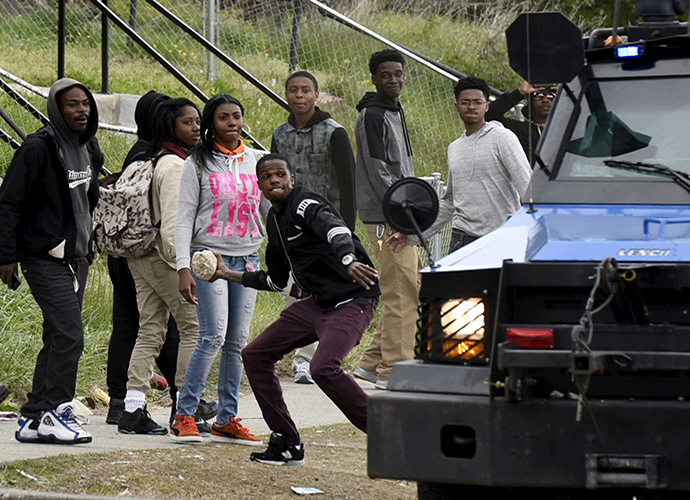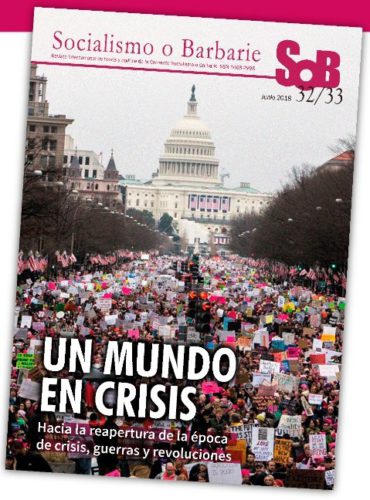
Last April 19, a young African American of 25 years old, Freddie Gray, was murdered in the American city of Baltimore. The perpetuators of the murder were “officers of the law”: policemen who, as in many other opportunities, detained a “suspect” (we ask, suspect of what?) and decided to execute him preventively. Of course, having dark skin makes you “suspicious”.
Gray’s murder produced a massive wave of indignation, especially among the black community. Through several days, huge demonstrations and protests challenged the six days curfew and the presence of thousands of members of the National Guard which were keeping the city practically occupied. Solidarity streched out throughout the country.
This is not the first time such events had occurred. Hundreds of similar events of police brutality against blacks and latins happen in the United States.
One of these events came out last year to the whole world after the revolts in Ferguson and the demonstrations in the entire country. A second wave burst in New York city after another murder perpetrated by the police.
Therefore, protests in Baltimore are not truly a novelty themselves, neither because of the trigger nor the people’s reaction. The novelty is that for the first time protests got the justice to charge Baltimore policemen with murder. This does not mean that they are going to be, in fact, punished, but it’s a breakthrough in one of the biggest United States taboos: the absolute immunity of the members of the repressive forces.
This is not yet the most important novelty, but how often cases of police brutality come to light, the fact that black community has had enough and the systematic popular response. It opens a new scenario where every new event unleashes a whirlwind of indignation, demonstrations and revolts.
The black movement of the United States has a long tradition. In the 50’s and 60’s it accomplished the formal recognition of civil rights, that is to say, that racism can’t express itself in segregation laws. However, racism has roots and expressions much deeper than merely the racial segregation. That is the reason why blacks’ revolts and demonstrations (especially, the poorest sectors) have been bursting so often. Many of those revolts were legendary: Watts in the 60’s, Los Angeles in the 90’s, etc.
It is true that something changed after the conquest of civil rights: a small “black middle class” emerged and even some African American millionaires, which could embody themselves into the system in various ways. Even more, some of them got important places in the political system: top civil servants, functionaries, etc. Obama is one of the most important examples.
But legal-formal rights do not destroy the core of racial segregation: the vast centers of poverty, the “ghettos” where African American which couldn’t ascent in social status cluster; meaning, the majority of black people.
The mere existence of this “colored” poverty centers is not unknown to the world: it is vastly represented in popular culture. Hundreds of movies and series happen in black hoods of big cities. Even entire musical genres were born in the ghettos: hip hop might be its greatest emblem.
A specific kind of racial segregation exists which is determined by social class: the vast part of population which is defined by being black and poor. An enormous social sector which stands in the lowest step of American society: that’s a place where there is no “American dream” or “exemplary democracy”. There is only the harshest reality of imperial capitalism: really high rates of unemployment, salaries too low to pay rent (and to afford studying) and police brutality focusing in a youth without future.
The breeding ground for the outbreak
This reality has existed for decades in American society, but it has been growing worse and worse. In the 70s and 80s, the deindustrialization process began to affect particularly the black sectors which worked in the traditional manufacturer centers. This process continued in the following decades, and took a quality leap in the great crisis of 2008. The unemployment rates shot up and salaries were even more deflated.
On the other hand, police brutality was also on the rise. Although American “security” forces were always of a racist (and deeply anti-worker and anti-popular) nature, this also took a quality leap from the 90s. Then, the infamous New York mayor, Rudolph Giuliani, introduced a new method to try to contain crime: to preventively stop and beat any suspicious person, to leave them rotting in jail afterwards.
During the two decades that followed the generalization of this “zero tolerance” policy (that is to say, not tolerating anyone with dark skin), American jails were crammed, to the point of not being sustainable even from a financial point of view. The USA is one of the countries with the highest rate of people locked down in relation to the total population. Of course, “colored” people are the segment which has been struck proportionally harder by this policy.
The combination of all these elements is the perfect breeding ground for the outbreak of enormous social tensions. All that it took was a trigger.
And the trigger, in a political sense, was the accumulation of experiences that different sectors of American society have been living since the great crisis of 2008. The burst of the Occupy Wall Street movement meant an inflection point, like we explained in a previous article.[2]
All over the world a new generation of young people emerged, and it irrupted in the political scene with big demonstrations. From the Tahrir Square of Cairo, the Indignados of Spain, the Chilean students, etc. What we have, from Socialism or Barbarism, depicted as a world-wide cycle of popular rebellions, originated by the global economic crisis. It has made its way, multiplying its reach thanks to “social networks” and the new communication technologies.
These worldwide and local coordinates generated a new political sensibility in great sectors of the population. Every new case of police violence is denounced, “viralized” in social networks and causes great protests, which end in clashes and even more massive demonstrations.
Another factor is the development of a new activism, which interconnects diverse problems: the antiracist collectives has strong bonds with the collectives for the rise of minimum wage, the collectives against adjustments and social inequality, etc.
What is the prospect for the anti-racist movement?
This movement, which grows bigger and bigger, has an enormous political value and a great development potential. However, it is essential to ask ourselves which are its strategic prospects, that is to say: how it can transform reality.
One of the political conclusions of the last few years is that racism can’t be solved by a mere step forward of africanamerican people on the institutional front. The “black president” Obama didn’t lift a finger to solve the structural poverty and institutional violence that black people suffer in the USA. Even more, he acted as a perfect “white racist” by condemning the rebellious youths of Baltimore because of their “violence”, without even denouncing the “violence” of the police institution which has been carrying out a policy of systematic executions.
The very city of Baltimore is a perfect example of the institutional advancement of African Americans: the mayor, the DA and a considerable part of the police force are black. Including three of the six policemen accused for the Gray murder.
This should be enough to demonstrate that it is not simply a matter of “skin color” of the officials of the capitalist and racist State. The problem is precisely the social and political content of said State. The whole State machinery is built on the foundation of exploiting and oppression the working class. In the USA a great part of the proletariat class is made up of black people and Latinos: that is why the objective function of the “black civil servants” of the capitalist State is to oppress their very own brothers and sisters.
On the other hand it isn’t either a matter of reforming police procedures or “educating the police”, as the government of Baltimore has been announcing to decompress the situation. Racism and brutality is the essence of the American State, shaped that way for centuries and determined by its class contents.
The true way out is the dissolution of these repressive apparatus and abolition of all the elements that carry on a regime of “racial segregation”: starting with ending unemployment, raising minimum wage, fixing the housing problem and granting massive access to public, free, quality education. That is to say: ending the whole political, economic and social capitalist regime of the USA.
To achieve this, the only strategic solution is an alliance between the anti-racist movement, the movements for immigrant rights, the movement for minimum wage and youth movements (like Occupy, among others). And the truly quality leap can be taken with the entry of great battalions of working movement, specially the mighty north American industry, breaking with decades of immobility.
By Ale Kur


